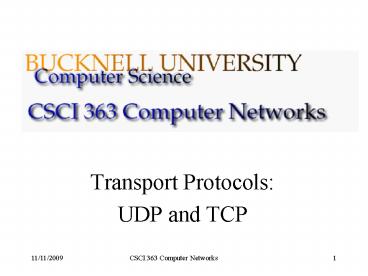Transport Protocols: - PowerPoint PPT Presentation
1 / 14
Title:
Transport Protocols:
Description:
What are the expectations of the functionality provided by underlying layers? ... flow-control allowing the receiver to throttle the volume of data transmitted by ... – PowerPoint PPT presentation
Number of Views:35
Avg rating:3.0/5.0
Title: Transport Protocols:
1
- Transport Protocols
- UDP and TCP
2
Expected Properties
- Guaranteed message delivery
- Message order preservation
- No duplication of messages
- Support for arbitrarily large messages
- Support for sender/receiver synchronization
- Receiver based flow control
- Support multiple application processes per host
3
Relationship with other layers
What are the expectations of the functionality
provided by underlying layers?
Application
Add to the functionality provided by Transport
Higher layers
Transport
Provides end-to-end features
Network
May drop, reorder, or duplicate messages. May
introduce arbitrarily long delays. May
limit the size of messages to a maximum value.
4
Transport Algorithms
- Simple asynchronous demultiplexing service
Reliable byte-stream service
Request/reply service
5
Simple Asynchronous DemultiplexingUDP
UDP PDU format
6
Reliable Byte Stream TCP
- Use the concept of ports to demultiplex streams
to the same host. - Guarantees reliable, in-order delivery of a
stream of bytes without duplication. - Implements flow-control allowing the receiver to
throttle the volume of data transmitted by the
sender.
Question What is the difference between
flow-control and congestion-control?
7
Segment Format
- TCP is a byte-oriented protocol.
Question What are the performance considerations
that drive the implementation of such a protocol?
8
TCP Connection Establishment
Three-Way Handshake
9
Socket Functions
socket()
TCP Server
bind()
TCP Client
socket()
listen()
accept()
connect()
TCP 3-way handshake
block until connection from client
data (request)
write()
read()
process request
data (reply)
write()
read()
end-of-file notification
read()
close()
close()
10
State Transition Diagram
Question How do your implement such a complex
protocol?
Question How do you verify that your
implementation conforms to the specifications?
Note Arcs are labeled with event/action.
11
Sliding Window
- TCPs sliding window algorithm
- Guarantees reliable delivery.
- Guarantees in-order delivery.
- Enforces flow control.
- Look again at the TCP segment header
The receiver tells the sender the number of
unacknowledged bytes of data it will allow (based
on buffer size).
12
Flow Control
LastByteAcked6LastByteSent
LastByteReadltNextByteExpected
LastByteSent6LastByteWritten
NextByteExpected6LastByteRcvd1
LastByteSent-LastByteAcked6AdvertisedWindow
LastByteRcvd LastByteRead 6MaxRcvBuffer
EffectiveWindowAdvertisedWindow-
(LastByteSent-LastByteAcked)
AdvertisedWindow MaxRcvBuffer
((NextByteExpected-1)-LastByteRead)
LastByteWritten LastByteAcked 6MaxSendBuffer
13
When The Window Hits Zero
- If the AdvertisedWindow reaches zero, the sender
is not permitted to send any more data. - TCP always sends a segment in response to a
received data segment with the latest values for
Acknowledge and AdvertisedWindow. The receiver
doesnt, however, send a spontaneous segment with
this information.
Question How does would the sender learn that
the AdvertisedWindow has become greater than zero?
14
Triggering Transmission
- Question How should TCP decide to send a
segment? - (You can answer this ignoring flow control for
now.)
Sending application
- As soon as MSS (maximum segment size) bytes have
been collected from sender. - Whenever the sending application explicitly
requests it (push). - Whenever a timer fires and then however many
bytes have been buffered so far are sent.
TCP































